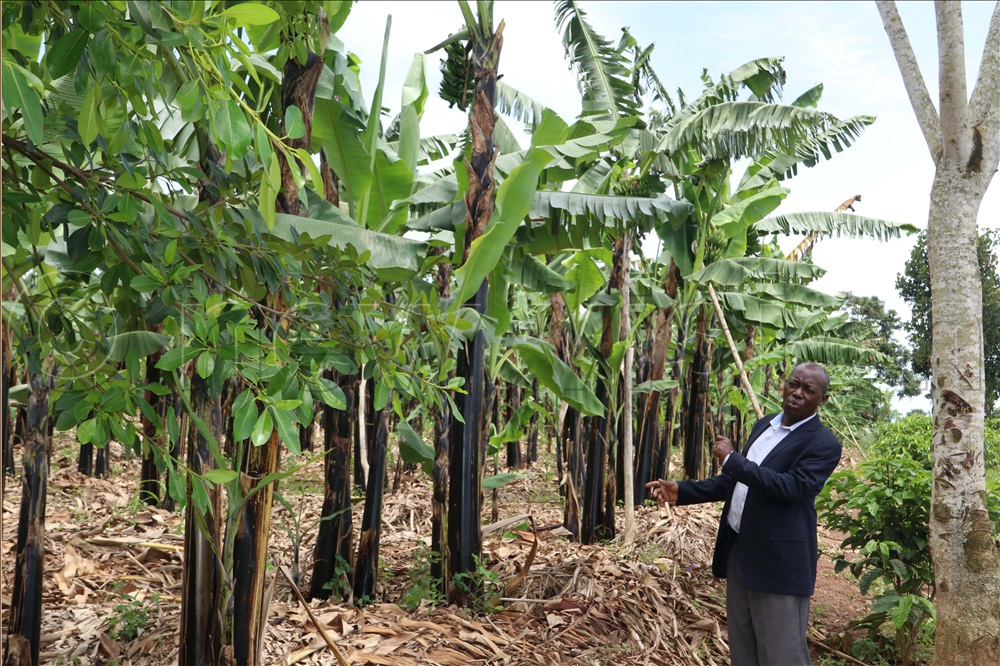Are you considering starting a commercial banana plantation in Uganda or establishing a small garden in your backyard? Whether you’re aiming for substantial yields and profits or enjoy homegrown bananas, you cannot get disappointed, writes Victoria Nampala Bugembe.
Bananas are a crucial food security crop in Uganda. Beyond their role in the diet, bananas produce local brew and supplement animal feeds.
Banana varieties in East Africa
East Africa has a variety of Banana including; East African Highland Bananas (EAHB)
Matooke (cooking bananas)
The most popular banana type in Uganda, especially in the central and western regions. It is mainly used for cooking and is a staple food for many households.
Its varieties include Nakitembe, Nakabululu, and Mbwazirume.

Mbidde (brewing bananas)
These are mainly used for brewing traditional beverages like Entundu and Nandigobe.
Plantain (gonja)
This is mainly grown in the highlands, particularly Kasese. It is often eaten roasted or fried and not as widely grown as others but is popular in local markets.
Dessert bananas
Sukalindizi
This is a small, sweet banana that is typically eaten ripe. It is common in Uganda and is often grown for local consumption and export.
Other local varieties
Kisubi
This is used in brewing but can also be consumed as a dessert banana.
Kayinja
A smaller variety is primarily used for brewing traditional beers and it can be eaten as food during the dry season at peak famine.
Environmental factors for growing bananas
Musinguzi Ahmed, a matooke vendor at Nakawa market says that bananas thrive at temperatures around 27°C. They require 1500-2500 mm of well-distributed rainfall annually and prefer a relative humidity of over 60%.
Soil: Bananas need deep, well-drained loam soil with high humus content. Ideal pH ranges from 5.6 to 7.5. Adequate potassium, nitrogen, magnesium, calcium, and phosphorus are essential.
Musinguzi adds that, when one has more than six banana plantations of good quality in a home, they can never lack food and in bumper harvest, the excess can be sold to get money.
He, however, noted that many farmers do not know how to look after banana plantations and they use pesticides instead of hand weeding which affects the quality of food from such a sprayed plantation during harvest season.
George Stephen Okotha, another banana farmer cautions farmers to first verify the variety of banana before planting because many varieties can give a farmer money throughout the year like plantain and sukalindizi if they are well looked after and they have a ready market throughout the year.
“Not all bananas are grown for food, there is a lot of value addition that can be added to matooke, and a farmer gets money but many of them are ignorant and thus grow for food only,” says Okotha.
Land preparation
Prepare the land by slashing the grass without burning it to preserve organic matter.
“Farmers must avoid burning grass because the act kills the soil nutrients but instead, it can be buried under soil to form manure for the banana”, he cautions.
A farmer can make two ploughings which are sufficient for a good seedbed.
First, all the drainage channels or soil conservation bunds along the contours of the garden should be established.
Banana planting
Bananas can be propagated vegetatively or by breeding but vegetative propagation is common.
Planting materials
Peepers: Very young suckers with only scale leaves.
Sword suckers: These are suckers formed from buds or eyes low on the corm, 30-60 cm tall, and favoured for their stable growth.
Maiden suckers: Older suckers over 60 cm tall; whose leaves are cut to minimize water loss.
Corm bits: Pieces of large corms with one or more eyes.
Caution.
Okotha encourages farmers to first ensure that the suckers are clean and free from pests. This can be done by cutting off roots, peeling the outer core layer, and treating it with pesticides for nematodes.
A farmer can easily use tissue-cultured suckers as clean planting materials.
Planting procedure
Bananas must be panted at the start of the rainy season in areas with a pronounced dry season.
Dig holes (2×3 ft) and space plants 3×3 meters apart.
Mix well-rotted manure or compost with topsoil and return it to the hole. For proper results in the initial stage, Biochar as organic manure is recommended for its soil fertility benefits and nutrient retention.
Place the sucker in the hole and cover with soil and if using corm bits, cover them with only a 5 cm layer of soil.
Managing the banana plantation
Desuckering: Remove excess suckers to manage harvest frequency and maintain proper spacing to avoid overcrowding and fighting for nutrients on the same plant.
Mulching: Use mulch like banana leaves, or dry grass, to conserve soil moisture and reduce water runoff, but avoid placing it too close to the plant to prevent pests from attacking the plant.
Staking: A farmer must support banana plants with Stakes against the wind, especially for varieties with large bunches that might fall before their gestation period.
Fertilizer application: Bananas need regular replenishment of soil nutrients. Use of farmyard manure, crop residues, or biochar organic manure. But remember not to place manure too close to the banana mat to prevent weevil infestation.
Harvesting bananas
Bananas typically mature in 12-18 months.
Mature bananas are firm, and the flower bract is dry and easily breaks off.
Harvest banana bunches using a curved knife or sharp panga by cutting the stem carefully.





